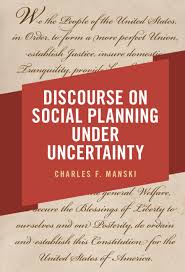Book Report: Charles Manski

In Fifteen Eighty Four, Cambridge University Press's academic blog, Department of Economics Professor Charles Manski discusses his new book, "Discourse on Social Planning under Uncertainty" which is scheduled to be published in January 2025.
A foundational objective of the Constitution of the United States is to “promote the general Welfare.” However, the Constitution does not define “general Welfare.” The Constitutional premise that the United States should promote the general welfare exemplifies frequent broad assertions that entities making societal decisions should aim to maximize social welfare. Such assertions may have rhetorical appeal, but they lack substance per se. They become meaningful only when several questions are answered: What constitutes social welfare? What are the feasible actions? What is known about the welfare consequences of alternative choices?
Maximization of welfare is a well-defined objective if enough is known about the welfare consequences of alternative choices to determine an unambiguous best action. Maximization is ill-defined if the consequences are sufficiently uncertain that no action is clearly best. The concern of my new book Discourse on Social Planning under Uncertainty is reasonable societal decision making in such settings.
What are the uncertainties with which planning must cope? They are too many and varied to summarize easily. Those that I have studied, all of which are discussed in the book, include uncertainties in medical risk assessment and prediction of treatment response, which inform clinical decision making. They include uncertainty in the epidemiological models used to predict the spread of infectious diseases, which inform choice of vaccination policy. They include uncertainty in the physical-science climate models used to predict future climate change, which inform choice of climate policy. And they include uncertainties regarding the labor supply behavior of workers, knowledge of which is essential to analysis of income tax policy.
I lay out basic themes in the opening chapter and then flesh them out. The three chapters of Part I are concerned with characterization of uncertainty. The five chapters of Part II describe my research analyzing particular classes of planning problems. The concluding chapter looks ahead to performance of future research on social planning under uncertainty, including a call for immediate action to improve pandemic planning and over the long term to reduce the fragility of human society.
This work has emerged from an intellectual journey that has spanned over fifty years. In retrospect, I see that the long duration was inevitable. I could not have written the book earlier because it combines research and thinking in three fields — welfare economics, decision theory, and econometric analysis of partial identification —- that developed separately from one another and in different time periods.
Welfare economic study of social planning began in the late 1700s, was formalized in the mid-1900s, and then progressed for several decades as a central concern of economics, but the subject has more recently become peripheral to the profession. Decision theoretic study of choice under uncertainty has advanced steadily since the mid-1900s, initially focusing on expected utility maximization, and more recently on approaches to decision making under ambiguity (aka deep uncertainty). Econometric study of partial identification had isolated precursors in the 1930s and 1940s, but it has developed into a coherent subject of analysis only from the 1990s onwards.
Different researchers have worked in these fields, so it is not surprising that they developed separately. Of particular importance is that welfare economics has primarily studied deterministic environments, whereas decision theory and econometrics are fundamentally concerned with uncertainty. I began to recognize the cross-field synergies around 2000. Since then, I have sought to build connections and to make the results useful to specific domains of planning.
Over the past twenty five years I have developed a program of research concerned with planning under uncertainty, embodied in numerous articles published in diverse academic journals. Some of this work has been abstract, using modern economics, econometrics, and decision theory to study general conceptual and technical issues. Some has analyzed specific planning problems.
Why then this book? Research published piecemeal in concise journal articles mainly communicates within fields, not across them. Here I offer a comprehensive treatment, a treatise. A book provides the opportunity to flesh out a worldview and juxtapose it with other viewpoints. It gives the space to explain analytical methods and show how to apply them. A book provides a foundation on which future work can build.
I expect the primary readers to be scholars and students who study public and welfare economics, mechanism design and decision theory, econometrics and statistics, operations research and systems analysis, moral philosophy and ethics. These fields of inquiry connect to planning under uncertainty in various ways. Yet they have interacted little with one another, no doubt a consequence of the prevailing siloing of academic disciplines.
While the book is mainly intended for an academic audience, I hope that a broader range of readers will find the non-technical exposition of themes in the two opening chapters and the concluding chapter to be accessible and engaging. The population as a whole should want research to credibly inform the evaluation and design of public policy. This is what I aim to achieve.

